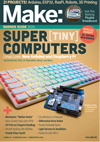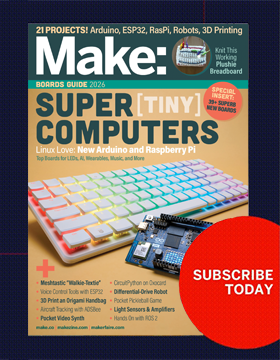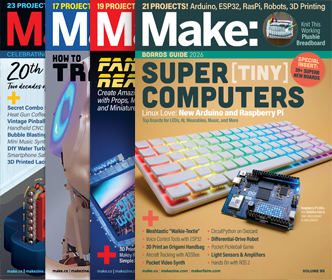
Paper Basket
WHAT WILL YOU MAKE?
A weaved basket made with recycled newspaper.
WHAT WILL YOU LEARN?
You will learn weaving and basket making skills using a recycled material.
STEPS
STEP 1
Cut the Strips
- Turn one newspaper sheet sideways.
- Make a hash mark every two inches.
- Mark the opposite side in the same way.
- Cut the strips by placing the ruler across two of the marks and cutting across with a craft knife.
- Make 20 strips.
STEP 2
Fold the strips
- Fold each strip in half, hotdog style (make sure that you don't cover up the side you want to show).
- Open the strip.
- Fold both edges into the center line you created on your first fold.
- Fold along the center line you originally created. You should now have a strip that is roughly 1/2 inch wide.
STEP 3
Weave!
- Lay 10 strips vertically. The 5 on the left should have the crease facing the left and the 5 on the right should have the crease facing the right.
- Weave a strip horizontally by going over, under, over, until you've gone all the way across. It might help to place a heavy object across the vertical strips to help keep them from moving.
- Weave in the rest of the strips. Make sure that each half of the strips have the crease facing out.
STEP 4
Cut the String
- Measure a length of thread that is a little over two times the circumference of the base.
- Cut it.
- Fold it in half.
STEP 5
Twine
- Loop the string around a strip so that one half of the string is underneath the strip and the other is on top.
- Twist the ends between the strip.
- Switch the positions of the string ends so that the one on top now goes underneath the next strip.
- Continue the twining process until you reach the beginning.
- Tie the ends of the string together.
STEP 6
Weave the Sides
- Start with one of the sides. Split them in half so that you have 5 strips on one side and 5 on the other.
- Cross the middle two strips.
- Weave both halves together.
- Tighten up the weaving.
- Temporarily secure the woven side with a paperclip.
- Weave together the remaining three sides the same way.
- Weave the sides into each other so it makes one solid shape.
STEP 7
Make the Edge
- Start with any two strips that are next to each other and fold one strip over the other.
- Weave this into the inside of the basket.
- Now fold over the one next to it and weave that one into to the inside of the basket.
- Continue this process until all of the strips have been folded into the inside.
STEP 8
Add Finishing Touches
- Cut off the remaining edges of the strips from the inside.
- Tighten up the strips by pulling each one from the base up through the top.
- Continue this until you think it's tight enough.
- Make the base flat by placing the basket upside down and over a container and placing a heavy object on top of it for several hours.
Materials:
- 4-5 Newspaper sheets
- String or thread
- Paperclips
- Craft Knife
- Scissors
- Ruler
- Cutting Mat or Cardboard
See More Projects in these topics:
Fabrication Paper CraftsSee More Projects from these themes:
Construction SiteMaker Camp
Please Note
Your safety is your own responsibility, including proper use of equipment and safety gear, and determining whether you have adequate skill and experience. Power tools, electricity, and other resources used for these projects are dangerous, unless used properly and with adequate precautions, including safety gear and adult supervision. Some illustrative photos do not depict safety precautions or equipment, in order to show the project steps more clearly. Use of the instructions and suggestions found in Maker Camp is at your own risk. Make Community, LLC, disclaims all responsibility for any resulting damage, injury, or expense.
Maker Camp Project Standards
Based on NGSS (Next Generation Science Standards)
CCSS (Common Core State Standards)
The Common Core is a set of high-quality academic standards in mathematics and English language arts/literacy (ELA).Geometry
- Grades K-2
- CCSS.MATH.CONTENT.K.G.A.1 Describe objects in the environment using names of shapes, and describe the relative positions of these objects using terms such as above, below, beside, in front of, behind, and next to.
- CCSS.MATH.CONTENT.K.G.A.2 Correctly name shapes regardless of their orientations or overall size.
- CCSS.MATH.CONTENT.K.G.A.3 Identify shapes as two-dimensional (lying in a plane, "flat") or three-dimensional ("solid").
- CCSS.MATH.CONTENT.K.G.B.5 Model shapes in the world by building shapes from components (e.g., sticks and clay balls) and drawing shapes.
- CCSS.MATH.CONTENT.K.G.B.6 Compose simple shapes to form larger shapes.
- CCSS.MATH.CONTENT.1.G.A.1 Distinguish between defining attributes (e.g., triangles are closed and three-sided) versus non-defining attributes (e.g., color, orientation, overall size); build and draw shapes to possess defining attributes.
- CCSS.MATH.CONTENT.1.G.A.2 Compose two-dimensional shapes (rectangles, squares, trapezoids, triangles, half-circles, and quarter-circles) or three-dimensional shapes (cubes, right rectangular prisms, right circular cones, and right circular cylinders) to create a composite shape, and compose new shapes from the composite shape.
- Grades 3-5
- CCSS.MATH.CONTENT.4.G.A.3 Recognize a line of symmetry for a two-dimensional figure as a line across the figure such that the figure can be folded along the line into matching parts. Identify line-symmetric figures and draw lines of symmetry.
- Middle School
- CCSS.MATH.CONTENT.6.G.A.4 Represent three-dimensional figures using nets made up of rectangles and triangles, and use the nets to find the surface area of these figures. Apply these techniques in the context of solving real-world and mathematical problems.
- CCSS.MATH.CONTENT.7.G.A.1 Solve problems involving scale drawings of geometric figures, including computing actual lengths and areas from a scale drawing and reproducing a scale drawing at a different scale.
- CCSS.MATH.CONTENT.7.G.A.2 Draw (freehand, with ruler and protractor, and with technology) geometric shapes with given conditions. Focus on constructing triangles from three measures of angles or sides, noticing when the conditions determine a unique triangle, more than one triangle, or no triangle.
- CCSS.MATH.CONTENT.7.G.A.3 Describe the two-dimensional figures that result from slicing three-dimensional figures, as in plane sections of right rectangular prisms and right rectangular pyramids.
- CCSS.MATH.CONTENT.8.G.A.1 Verify experimentally the properties of rotations, reflections, and translations.
- CCSS.MATH.CONTENT.8.G.A.3 Describe the effect of dilations, translations, rotations, and reflections on two-dimensional figures using coordinates.
- CCSS.MATH.CONTENT.8.G.A.4 Understand that a two-dimensional figure is similar to another if the second can be obtained from the first by a sequence of rotations, reflections, translations, and dilations; given two similar two-dimensional figures, describe a sequence that exhibits the similarity between them.
National Core Arts Standards
The National Core Arts Standards are a process that guides educators in providing a unified quality arts education for students in Pre-K through high school. Also see Standards with cross-cutting anchors in Creating, Performing, Responding, and Connecting through art for Visual Arts.NGSS 3-5.Engineering Design
The Next Generation Science Standards (NGSS) are K–12 science content standards.- 3-5-ETS1-1. Define a simple design problem reflecting a need or a want that includes specified criteria for success and constraints on materials, time, or cost.
- 3-5-ETS1-2. Generate and compare multiple possible solutions to a problem based on how well each is likely to meet the criteria and constraints of the problem.
- 3-5-ETS1-3. Plan and carry out fair tests in which variables are controlled and failure points are considered to identify aspects of a model or prototype that can be improved.
NGSS MS.Engineering Design
The Next Generation Science Standards (NGSS) are K–12 science content standards.- MS-ETS1-1. Define the criteria and constraints of a design problem with sufficient precision to ensure a successful solution, taking into account relevant scientific principles and potential impacts on people and the natural environment that may limit possible solutions.
- MS-ETS1-2. Evaluate competing design solutions using a systematic process to determine how well they meet the criteria and constraints of the problem.
- MS-ETS1-3. Analyze data from tests to determine similarities and differences among several design solutions to identify the best characteristics of each that can be combined into a new solution to better meet the criteria for success.
- MS-ETS1-4. Develop a model to generate data for iterative testing and modification of a proposed object, tool, or process such that an optimal design can be achieved.
NGSS HS.Engineering Design
The Next Generation Science Standards (NGSS) are K–12 science content standards.- HS-ETS1-1. Analyze a major global challenge to specify qualitative and quantitative criteria and constraints for solutions that account for societal needs and wants.
- HS-ETS1-2. Design a solution to a complex real-world problem by breaking it down into smaller, more manageable problems that can be solved through engineering.
- HS-ETS1-3. Evaluate a solution to a complex real-world problem based on prioritized criteria and trade-offs that account for a range of constraints, including cost, safety, reliability, and aesthetics as well as possible social, cultural, and environmental impacts.
- HS-ETS1-4. Use a computer simulation to model the impact of proposed solutions to a complex real-world problem with numerous criteria and constraints on interactions within and between systems relevant to the problem.
ALL DONE? SHARE IT!
Share pictures and videos of your cool build! Be sure to use #maketogether or #makercamp
POST YOUR PROJECTS


